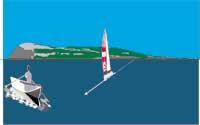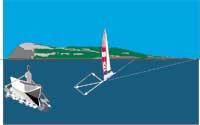From the movement
Once the newspapers in Paris published an astonishing announcement indicating how to make a trip with twenty-five cents, without any effort and at an affordable price. Some innocents sent the aforementioned money and each of them received a letter in which they read:

“Sit quietly at home and remember that the Earth is spinning. As you are parallel to Paris, that is, in 49 you travel 25,000 km a day. If you like the beautiful views, open the window and enjoy the spectacular panorama of the kneading.”
Of course, the author of the announcement was accused and after reading the sentence and paying the fine, taking a dramatic attitude, pronounced the famous phrase of Galileo:
- Eppur, if you mouve! (And yet it moves).
In fact, the reason was the one denounced because each of the inhabitants of the terrestrial sphere makes two trips, one around the axis of the sphere and another much faster, the movement of translation around the Sun. Our planet, and all its inhabitants, travels in space thirty kilometers per second, and this, in addition to its movement around its axis.
And all this reminds us of the relativity of movement. Normally when we talk about a trip, it is evident that we are talking about movement with the Earth, so if I have not changed my position regarding the Earth I usually say that I am “still”, even if we know that the Earth has its movement. Let's look at another example of relativity of movement.
Suppose a grouper operates on a lake and by the arrow “a” we represent the direction of its movement (see attached figure). In turn, and perpendicularly to him, comes a sailboat and the arrow “b” indicates its meaning. If the reader of this work were asked where the sail has departed, he would answer us immediately from point M of the coast. But if we asked the same question the rower would tell us a very different point. Why?

For this shipyard the sailboat does not go perpendicularly to its direction. He does not realize his movement and vice versa, he believes that while he is still, everything around him moves with the speed he has but in the opposite direction. Therefore, for him, the sailboat, in addition to having a movement of the arrow “b”, has a movement that indicates the line of points, that is, like that of the row “a”, but in the opposite direction. These two movements, real and imaginary, of the sailboat are added according to the rule of the parallelogram and according to the roster the sailboat goes through the diagonal of the parallelogram. Consequently, he considers that the sailboat did not depart from point M of the coast but from the N, that is, from another one that is much more advanced in the sense of the rowing ship.
As we go with the earth following its orbit and see the rays of light coming from the stars, the error we make when considering the positions of the stars is the same as that made by the sailor of the rower, and it seems to us that there is a little later (depending on the movement of the Earth) than where the stars are. Since the Earth's translation speed is very small (10,000 times less) than light, the deviation in the image of stars is very small. However, this deviation can be measured by astronomical devices. This phenomenon is called light aberration.
To the reader, whenever he is interested in the relativity of the movement, without altering the peculiarities of the movements of the ships, we ask the following questions.
- What direction does the rowing boat have for sailboat passengers?
- Where is the rower going according to the sailboats?
Think about whether you have made a skewer, a drawing or another and you have understood well what was said here, you will have no trouble finding correct
answers.
Buletina
Bidali zure helbide elektronikoa eta jaso asteroko buletina zure sarrera-ontzian











